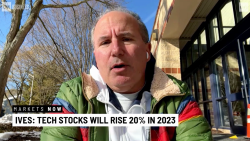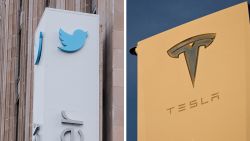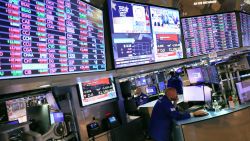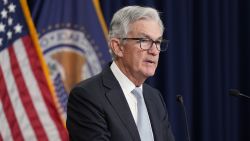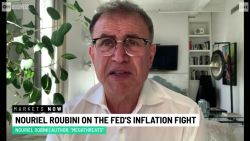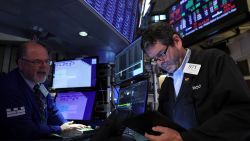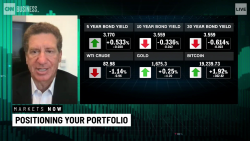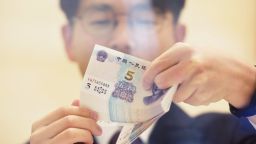A version of this story first appeared in CNN Business’ Before the Bell newsletter. Not a subscriber? You can sign up right here. You can listen to an audio version of the newsletter by clicking the same link.
Consumer prices in the United States continued to surge in November, exacerbating anxiety about rising inflation among Americans.
The consumer price index rose by 6.8% last month, the highest its been since June 1982, according to the Bureau of Labor Statistics.
The Biden administration was already trying to tamp down worries about another high reading before the data was released. In October, annual inflation rose 6.2%, the largest increase in three decades.
“Tomorrow, we will get a report on consumer prices that experts expect to be elevated again, driven in part by energy prices and used car prices,” President Joe Biden said in a statement Thursday. “Fortunately, in the weeks since the data for tomorrow’s inflation report was collected, energy prices have dropped. The price of gas at the pump has already begun to fall nationally, and real pump prices in 20 states are now lower than the 20-year average.”
There’s been another change, too: Since the data was collected, the Omicron variant has entered the picture.
Economists are currently locked in debates about how the variant will affect the inflation outlook. Much depends on the severity of the strain and whether governments decide to implement harsher rules to limit its spread. But there are a few important elements to consider.
Effect on demand for goods: If people start spending more time at home again, they’re likely to shell out less money on services like eating out and haircuts and more on goods like electronics and homewares.
Demand for goods is already running hot, contributing to the supply chain issues that have been a key contributor to inflation. On this front, Omicron could make matters worse.
Effects on supply of goods: Another factor that’s been stopping supply chains from getting back to normal has been closures of factories in countries like Vietnam.
Should plants around the world be forced to halt or cut production because of fears of Omicron or rising infections, that could also add to inflation.
Effect on demand for energy: On the other side is demand for energy. As economies have reopened, purchases of fuel have soared. The spike in the cost of energy played a major role in broader price increases this fall.
If restrictions return and travel declines, that would ease demand for energy, helping inflation move lower.
“This hit to energy prices means that the initial effect of a major Omicron wave is likely to be disinflationary rather than inflationary,” Neil Shearing, group chief economist at Capital Economics, wrote in a note to clients this week.
Big picture: If Wall Street doesn’t have a strong reaction to the November inflation data, this is probably why. Looking ahead, the outlook for inflation is murkier, and it will take some time to see how the situation unfolds.
The US dollar has surged. China’s yuan is doing even better
China is grappling with a slowing economy, yet its currency has rarely been stronger. The yuan is also outperforming the US dollar this year even as the Fed prepares to hike interest rates. So what gives?
The latest: The Chinese currency has soared more than 8% in 2021, according to an index that tracks the yuan’s performance against 24 other currencies, my CNN Business colleague Laura He reports. Based on that gauge, it’s just 0.3% short of its previous record high set in November 2015.
The yuan has also gained ground on the dollar. It’s risen between 2.4% and 2.8% this year against the greenback — depending on whether it trades in China or offshore. Both versions are now at their highest levels against the dollar in three years or more.
Heading into December, the yuan’s gain this year was “the best in the world,” said Marc Chandler, managing director for Bannockburn Global Forex, an Ohio-based capital markets trading firm.
Breaking it down: The main reason for the yuan’s surge is the amount of money flowing into China, largely thanks to surging exports, said Larry Hu, head of China economics at Macquarie Group.
China’s economy has been hit in recent months by shipping disruptions and a deepening property crisis. Even so, exports have held up well. Shipments from China reached nearly $326 billion in November, a 22% jump over the year before, according to government statistics released Tuesday.
Another reason for the yuan’s rally, according to analysts, is international enthusiasm for Chinese bonds as investors chase higher returns.
On the radar: Beijing appears increasingly uncomfortable with the yuan’s rapid appreciation. The People’s Bank of China announced Thursday it would raise the foreign exchange reserve requirement ratio to 9% from 7% — the second hike in the ratio this year. The move will force Chinese financial institutions to keep more foreign money in reserve, and has been widely interpreted as an attempt to temper the yuan’s rally.
“It is desirable for the [yuan] to stay largely stable [for] the Chinese authorities, in our view,” said Becky Liu, head of China macro strategy at Standard Chartered Bank.
Could Elon Musk join the Great Resignation?
Want more proof that the Great Resignation has taken hold of American workers? Even the richest man on Earth is thinking about leaving his job.
See here: Tesla (TSLA) CEO and SpaceX founder Elon Musk tweeted late Thursday that he was “thinking of quitting” his jobs and “becoming an influencer.”
Musk is a notorious Twitter troll, and anything he says should be taken with a grain (or perhaps a large spoonful) of salt.
But some investors — who have backed Tesla in large part because they see Musk as a visionary — may be taking him seriously. Shares of the world’s most valuable automaker fell in premarket trading Friday before bouncing back.
Step back: The number of US workers who are quitting their jobs remains elevated, though the pace of resignations is easing. In October, 4.2 million Americans left their positions, a decline from September.
Even top executives have been part of the trend. CEO turnover jumped in the first half of 2021 as companies brought in new talent to manage the recovery from the Covid-19 pandemic and overworked execs announced retirements, according to recruiting firm Heidrick & Struggles.
Up next
The Consumer Price Index for November posts at 8:30 a.m. ET. The first reading of the University of Michigan’s consumer sentiment survey for December follows at 10 a.m. ET.
Coming next week: Central bankers from the Federal Reserve to the European Central Bank will make big decisions about how to address inflation.




